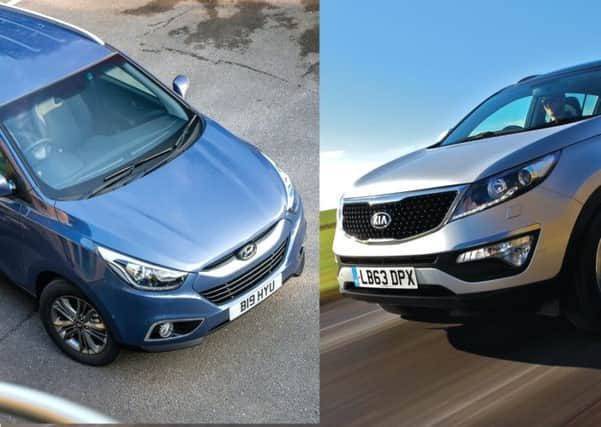Head to head review: Hyundai ix35 v Kia Sportage


That’s now the case with our cars. Since they first appeared, they’ve mostly all had the same basic structure of chassis and a wheel at each corner but with the development and rationalisation of the industry that’s been taken to a new level.
My daughter has just bought a new Seat Mii – but only after she discovered that it was really a Spanish-built Audi under the surface. That’s not strictly true of course but Seat, Audi, VW and Skoda do share the same structure and countless components as partners in the VAG Group. That gives economies of scale and reduces research and development costs, with savings which hopefully are passed on to the eventual customer.
Advertisement
Hide AdAdvertisement
Hide AdThere are many similar examples such as the partnerships between Renault and Nissan but one of the most interesting is the Kia and Hyundai family where the respective parts of their ranges appear to compete directly with each other.
Take the small SUV Kia Sportage for example. It’s been a big success since it first appeared, bringing some much-needed styling to the segment. It’s a direct competitor with Ford’s Kuga, Nissan’s Qashqai and most interestingly, the ix35 from Hyundai, which is even built in the same factory in Slovakia. Effectively they are the same car under the surface, so how do they compare on the road?
Putting them head to head, they are surprisingly different, with their own personalities. Personally I prefer the looks of the Sportage which is more curvaceous, more distinctive and just generally more attractive.
The Hyundai is a bit chunkier and, with squarer lines, creases down the flank of the bodywork and bigger headlamps, appears to be slightly larger. On the inside the dials and instruments are obviously in pretty much the same place and no doubt have identical wiring and general gubbins behind the scenes but outwardly have their own distinctive looks.
The 1.7-litre engines and transmission are the same but differences in weight and profile mean that the Kia has slightly better performance figures with faster acceleration, lower CO2 and better claimed economy. Those differences are largely imperceptible on the road and both cars are very capable, secure and well controlled with a smooth gearbox and surprising guts from what is a pretty basic power unit.
The build quality of both is excellent and certainly comparable with more expensive models from the likes of Volkswagen, Ford or Honda. Both cars give great peace of mind too with superb warranties.
In the case of the Kia, it’s the best in the business with seven years or 100,000 miles, which no other manufacturer has chosen to match since the company introduced it at the start of their offensive on the market in 2007. The Hyundai gives a five-year warranty with unlimited mileage, which would be better if you’re going to be clocking up the miles.
The level of standard equipment is remarkable for the price. Both come with full satnav and the leather seats are heated in the front, and the back – something usually found only in expensive executive cars.
Advertisement
Hide AdAdvertisement
Hide AdBoth have electric folding door mirrors, which may seem like a luxury but with parking spaces at a premium and apparently shrinking in the city centres, are more essential than ever. By tucking in they are less likely to suffer damage while parked in the street so you can avoid the hassle and cost of having to replace the entire unit.
Another small touch on both cars is the extending sun visors which can cover the small areas which would otherwise be missed when the sun is low in the sky.
While some of the other major manufacturers have been going through hard times of late, Kia and Hyundai have been riding the crest of a wave, supplying good quality and capable cars at attractive prices.
Just recently Kia announced their best-ever half-year sales with more than 40,000 cars registered in the first six months of 2014 and a sales record for June alone – and much of that is down to the Sportage.
Whether that or the Hyundai is the one for you is quite simply down to personal preference on styling and general “feel”. Whichever you go for, you’ll struggle to get anything better at the price.
VITAL STATS
CAR Kia Sportage 1.7 CRDi ‘3’ Satnav
PRICE £23,900
ENGINE 1,685cc, 4 cyl, 114bhp, 192 lbs/ft
PERFORMANCE Max speed 107 mph. 0-60 mph 11.9 secs
ECONOMY 52mpg combined
CO2EMISSIONS 143g/km
CAR Hyundai ix35 Premium 1.7 CRDi
PRICE £22,845
ENGINE 1685cc, 4 cyl, 114bhp, 192 lbs/ft
PERFORMANCE Max speed 108 mph. 0-62 mph 12.4 secs
ECONOMY 50mpg combined
CO2EMISSIONS 147g/km